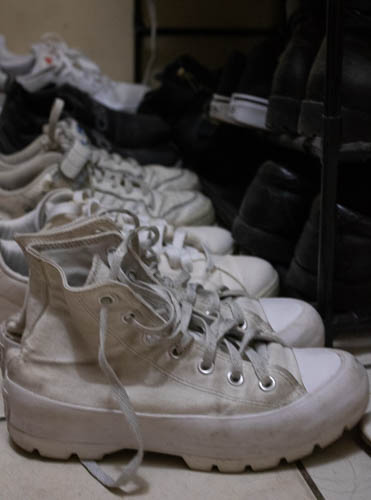It is something you don’t think about until you see someone else do the opposite. Cultural influences play a large role in what seems normal, impacting even small decisions like what to do with one’s shoes. For those who lived their entire lives taking their shoes off before going inside their house, it may seem gross to see others not doing the same. For those who keep their shoes on, the other side might seem bizarre. Nonetheless, once people from these opposing camps decide to become roommates, it is one of the first battles they must overcome before moving in. Choosing the right argument for either side determines the fate of their apartment and should be thought through carefully.
The biggest concern, and perhaps the most obvious, against wearing shoes indoors is sanitation. An article in The Washington Post about this very topic cites a virology professor who found various fecal bacteria on nearly all shoe samples taken, and E. coli on several as well. But it is not just gross material that can trek its way into one’s home. Toxins and pollutants could find their way in as well, thus contributing to their build-up indoors and increasing the risk of accidental inhalation or ingestion of these health hazards. In addition, it increases the cleaning burdens — with this habit, floors build up dirt faster and require more regular maintenance so as to prevent damage.
Coincidentally, those on the opposing side also have health concerns with not wearing shoes inside, primarily with young children and their growing immune systems.
Much like a pet, the immune system requires training. As these immune cells develop, one of the most important things they learn is recognizing the differences between foreign and “self” molecules. This might seem like a simple concept — immune cells need to attack threatening invaders but not the body — but it is much more complicated than that. In reality, not all foreign molecules are harmful. So not only do immune cells need to recognize these foreign molecules from their own bodies, they also need to distinguish the threats from the harmless and program themselves to only attack the threats. This concept is called tolerance. Of most relevance here is peripheral tolerance: training immune cells to ignore signals from foreign but harmless molecules, pollen being one example. For this to happen though, the body needs to be exposed to pollen. After all, if the body never gets to meet these molecules, it will never know that it needs to tolerate them.
“So not only do immune cells need to recognize these foreign molecules from its own body but they also need to distinguish the threats from the harmless and program itself to only attack the threats.”
For this reason, some studies have found that children raised in environments void of microbes, both nonharmful and harmful, are more likely to develop allergies. They argue that these overly clean homes prevent children from developing peripheral tolerance. When the developing immune cells do not meet different types of foreign molecules, they may end up overreacting to anything new that they encounter later on, unsure whether they are being threatened. This is particularly relevant in modern society as hygiene practices have significantly improved over many decades, and even more so in cities.
But would wearing shoes inside really mitigate the risks of developing allergies? It seems unlikely. While exposure to harmless microbes is healthy, this practice also increases risks in exposing the household to harmful microbes, which to most, is not a good tradeoff to make.
Many other arguments exist for and against wearing shoes indoors. Climate, the house’s condition, and other foot-related health issues may cause one to lean more towards one side than the other. Some take to wearing indoor shoes to gain the same benefits of wearing footwear inside while preventing the spread of dirt and microbes across their home. Whatever the decision is, it is important to be conscious of these hygiene habits between everyone in the household to ensure no one steps on each other’s toes, with or without shoes on.






